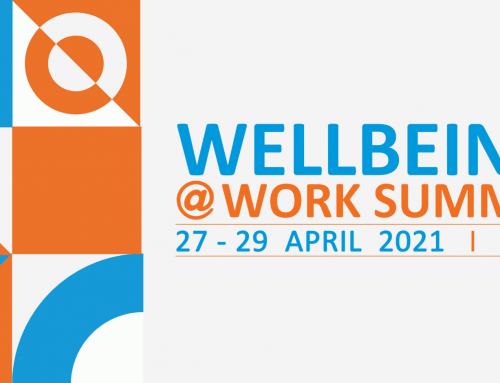Perhaps battling my way across London and arriving in a highly stressed state wasn’t the best way to arrive at the Workplace Wellbeing and Stress Summit that took place at the end of last year in London!
Across all of the speakers, the underpinning message was that ‘workplace wellbeing of employees is a key contributor to business performance‘ and those companies who take that perspective and are more proactive, enjoy better results than those who don’t!
It was a good message for me to hear, and it was encouraging to listen to more and more evidence coming from business leaders to support the wellbeing case, which is adding a lot of weight to the argument, moving workplace wellbeing from a ‘nice to do’ to an essential part of any people or talent management strategy and approach.
So what’s the formula for workplace wellbeing success?
Where do you start?
How much will it cost?
These were just some of the questions that were discussed at the Summit, and the responses fit into nine areas:
1. Genuine Concern

87% of People In The UK Are Not Engaged
Workplace wellbeing starts with a genuine concern about the wellbeing of employees from the CEO down. Gallop and Healthways found, for instance, that across all nations, the belief that a company genuinely cares about an employees’ wellbeing was the most important factor in engagement. Whilst we all work for companies and brands, ultimately we work for people and the leader of any team will make the biggest difference to employee engagement, something which isn’t a particularly high number across UK industry, with as much as 87% of people not engaged with their work!
2. A Plan and a Vision
Create a plan for workplace wellbeing including a strategy containing the vision of what success looks like including how wellbeing fits together and aligns with other functions such as rewards, health and safety and training; clear goals and measurements to track as you move towards that future state.
Successful companies have been able to show the interconnectivity, and appreciate that they employ people who have lives containing many responsibilities that they are trying to balance. At times these different components of life spill into one another and we need support to be able to cope. ‘Be flexible with your staff, and they will be flexible with you’, has always been my philosophy, and yes, I have been taken for a ride on more than one occasion, but having managed large teams of people for almost 20 years now (I can’t believe it has been that long), they are the exception rather than the rule.
3. Leveraging Resources and Building Awareness

Leverage The Right Resources For A Wider Impact
Fit your services and activities into a framework, and don’t underestimate the resources required to build awareness and engagement. A common theme was the number of services offered by employees, but there was real lack of awareness and therefore engagement.
For example, at Telefonica, only 25% of their staff were aware of many of the wellbeing initiatives available to them. So perhaps it’s better to leverage more resources for fewer things to have a wider impact.
That was certainly my experience with running a workplace wellbeing fair at Reed Business Information (RBI) recently, which had a big impact on raising awareness of wellbeing in the company, engaging over 1k people (more than half of the company) in some way and creating a positive ripple effect throughout the business.
4. Multiple Channels
Use multi-media and multiple channels to share and spread the word of the workplace wellbeing message and story, joining it together. The great thing about internal communication (as opposed to external) is that you do have many opportunities to reach your audience.
Think about all of the touchpoints you have internally from email; internal social networks such as Yammer; an Intranet possibly; f2f meetings and presentations; signgage around the offices (including lifts and loos). In short, there’s ample opportunity to engage employees and boost the word of mouth.
The key is to create a story and then tell that story via words, pictures or video and share it through the channels. Ideas shared at the summit included using personal case studies of change (BG got two engineers to keep video diaries); video overviews; funny cartoons; a message from the CEO; local advocates. There’s really no right or wrong answer, but remember it needs resource to plan, seed and spread.
5. Making Good Use of the Data
Make data your friend. Not data itself, but the insight provided from staff surveys and focus groups; absenteeism data and other sources will help you understand the real issues and tailor and prioritise interventions based on this insight. Brainstorming ideas of what you can do to boost wellbeing with staff will result in a long list of ideas; so how do you decide what to do first?
The data will guide you and give you confidence that you’re doing the right thing in the first place; and will also give you evidence to demonstrate impact to secure ongoing investment as CFOs have many requests for funding from product, marketing and sales people, all of whom will have strong cases and loud voices; so learn the rules of the game and play it well so that you can influence investment decisions and not just wait there saying ‘we need budget’ as though the ‘God of Money’ will come and sprinkle funds without any business case at all.
6. Find Like-Minded People

Build A Team
Don’t work alone. Depending on your starting point, moving wellbeing up the company’s agenda may feel like an enormous mountain to climb, so remember, Rome wasn’t built in a day and it certainly wasn’t built by one person. A good starting point is to gather together some like-minded people to feed into a shared vision of what could be possible; and not only like-minded people, but those with skills and influence that could really help. For instance, people who like organising events; run facilities or manage the canteen.
7. Leadership Engagement
Engage senior management – not all of them, but it’s essential to have a board or influential director sponsoring the programme and able to champion it at the most senior level. Telefonica highlighted this in their case study and have got three key sponsors blogging and doing all kinds of activities to support engagement.
Ultimately you’re looking for leadership engagement so that they talk about it, at the minimum and ideally lead by example, adopting the tenets of well-being for themselves, encouraging others to do so, and actively participating in well-being programs. Our wellbeing programme kicked off with a 5k run, and I was delighted that our Global Chairman took part. It made a real difference.
8. ‘Soft skills’ Training

Training Will Help
Train your managers – many managers do not have the soft skills deemed necessary to talk to their staff about any sensitive issues, with mental health being one such issue. Fujitso worked with the mental health charity, Mind, to run training sessions to help managers understand how to approach mental health issues within their team. Emotional wellbeing is an important part of any wellbeing strategy, and it’s interconnected with so many things. Unlike physical wellbeing, it’s silent and can’t be seen.
9. Resilience as a Skill
Focus on resilience as opposed to stress management. Whereas the latter is very short-term, resilience is about supporting people and enabling them to bounce back and prevent negative stress in the first place. Resilience is about being strong, and fighting through. According to Dr Amy Armstrong, Research Fellow at Ashridge Business School, it’s more about being adaptable and flexible and be able to move forward in the face of difficulty. It’s no wonder therefore that in ever increasingly dynamic business environments, resilience is becoming the number one skill that CEO’s desire.
How do you improve your resilience? It’s not one thing but the many things that come together including: being clear about what really matters to you both now and in the future; getting optimal sleep, having sufficient support at home and at work (so look after your relationships), doing exercise, eating well and continuing to learn.

Wellbeing & Performance Are Linked
So, it does seem from what has been presented at the Wellbeing and Stress Summit 2014 that businesses are starting to recognise more and more that ‘wellbeing of employees is a key contributor to business performance’- which is great news. Is this the case at your workplace? What can you do to raise awareness, find like minded co-workers or engage a senior executive?
If you want to connect with me about any of the points raised in this article, and about any aspects of wellbeing at your work – drop me a line at lawrence (at) getrawenergy.co –or join our mailing list below and get 7 additional tips to boost your own, personal resilience.







